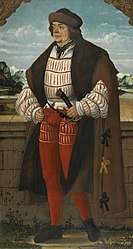File:Jester Knight Christoph by Hans Wertinger (1515, Thyssen-Bornemisza, Madrid).jpg
Vai alla navigazione
Vai alla ricerca

Dimensioni di questa anteprima: 319 × 598 pixel. Altre risoluzioni: 128 × 240 pixel | 256 × 480 pixel | 409 × 768 pixel | 546 × 1 024 pixel | 1 599 × 3 000 pixel.
File originale (1 599 × 3 000 pixel, dimensione del file: 5,28 MB, tipo MIME: image/jpeg)
Cronologia del file
Fare clic su un gruppo data/ora per vedere il file come si presentava nel momento indicato.
| Data/Ora | Miniatura | Dimensioni | Utente | Commento | |
|---|---|---|---|---|---|
| attuale | 16:14, 16 apr 2017 |  | 1 599 × 3 000 (5,28 MB) | Elsbeere | same source, new url: https://www.museothyssen.org/node/16661; file now larger available |
| 22:10, 29 lug 2014 |  | 539 × 1 000 (148 KB) | Shakko | {{Information |Description=Hans Wertinger The Court Jester known as "Knight Christoph" 1515 Oil on canvas 113 x 61.5 cm Museo Thyssen-Bornemisza, Madrid INV. Nr. 434 (1934.32) Hans Wertinger was a German painter active in the first third of the 16th c... |
Pagine che usano questo file
La seguente pagina usa questo file:
Utilizzo globale del file
Anche i seguenti wiki usano questo file:
- Usato nelle seguenti pagine di de.wikipedia.org:
- Usato nelle seguenti pagine di en.wikipedia.org:
- Usato nelle seguenti pagine di www.wikidata.org:


